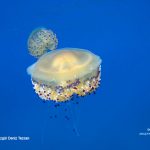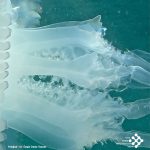Jellyfishes Species
Macrorhynchia philippina / Stinging Hydroid
This species can deliver a painful sting.
Subtidal zones on rocks and coral rubbles are this species habitat. Color: Stems and branches dark brown to black, hydrocladia pale grey, male gonophore purple to black, female cream to pale orange.
Macrorhynchia philippina Kirchenpauer, 1872
Aequorea vitrina / Cyristal Jelly
Umbrella saucer-shaped, thick in centre, gradually thinning towards margin.
Stomach about half width of disc. Radial canals 60-100; gonads extending along almost their entire length. Tentacles more than three times as numerous as radial canals.
Aequorea vitrina Gosse, 1853
Chrysaora hysoscella
The color of their body can be in shades of brown, yellow and red.
It has a long and slender manubrium which leads onto 4 oral arms that are fused at a short distance from its base. Chrysaora hysoscella generally occurs in coastal waters from spring to the end of summer. Its lifespan is about one year. It is abundant in the world’s oceans, including the Mediterranean and Aegean Sea coasts of Turkey. It also occurs in the Marmara Sea since the 2000’s. Like other jellyfish venom, Chrysaora hysoscella may cause painful and itchy red rash.
Chrysaora hysoscella (Linnaeus, 1767)
Aurelia aurita
It is a widely distributed species in the seas and oceans. It is abundant in the Atlantic, Pacific and Indian Oceans and in the Black Sea, Marmara Sea, Aegean Sea and Mediterranean Sea coasts of Turkey.
This jellyfish is non-venomous. It can be seen usually in the polluted coastal waters. Rarely, they can be found in brackish water. Hundreds or even thousands of individuals can be gathered in shallow water. This kind of blooms clog the fishing nets, so the fisheries is adversely affected. When they are washed up onto the shore by storms, they cause unpleasant situation on beaches both in the point of view and bad smell.
Aurelia aurita (Linnaeus, 1758)
Carybdea marsupialis / Box Jellyfish
This species is a mildly venomous species of cnidarian, in the small family Carybdeidae within the class Cubozoa.
Jellyfish belonging to the Cubozoa class are named “cubomedusae” or “box jellyfish” due to the cubic form of its umbrella. The small box jellyfish will grow up to 30-40mm which is the size of adult individuals which are able to reproduce. Although Carybdea marsupialis is not a species common to the Mediterranean Sea, over recent decades it has been detected at some points in the Adriatic Sea and massive appearances of this cubomedusa were registered in some coastal zones.
Carybdea marsupialis (Linnaeus, 1758)
Rhopilema nomadica
Rhopilema nomadica is not well known in our coasts.
Rhopilema nomadica has a nearly spherical umbrella. It has no marginal tentacles. The nematocysts are found on the oral arms and the edge of the umbrella. It is a “Lessepsian” species that entered from the Red Sea to the Mediterranean Sea. It feeds on planktons. It has a high reproductive potential since it can reproduce both sexual and asexual. Therefore, in short periods and especially from June to September, it can be seen more often and creates potential danger for swimmers, fishermen and divers.
Rhopilema nomadica (Lotan et al., 1995)
Phyllorhiza punctata
It’s a native species to the western Pacific.
It is not venomous. It is tolerant to a wide range of salinities and temperatures. This species is generally found in the coast of Brazil, Hawaiian Islands and the Gulf of Mexico, and it was first reported from the Israeli coast in 2009.
Phyllorhiza punctata Lendenfeld, 1884
Cotylorhiza tuberculata
Cotylorhiza tuberculata is an endemic species to the Mediterranean Sea (found only in the Mediterranean), including the Turkish waters.
Its umbrella can reach up to 40 cm. It is a large, but harmless jellyfish species. Middle of the umbrella is yellow or reddish in color. This part is round and quite hard, with short appendages providing movement. There are oral arms look like flowers or corals under the umbrella. At the tips of oral arms, there are several buds, blue-violet in color. The contact does not cause pain but the it may damage the animal, so should be avoided. This jellyfish, just like tropical corals, hosts symbiotic unicellular algae and thus considered to live like a plant. It’s harmless for fish and small fish use it as a shelter and benefit from its shade.
Cotylorhiza tuberculata (Macri, 1778)
Drymonema dalmatinum
Drymonema dalmatinum is one of the largest jellyfish in the Mediterranean.
Drymonema dalmatinum is a venomous jellyfish and it is extremely annoying and dangerous. Its last report was from the Croatian coasts and it is expected to reach the Italian coasts. This is originally from the Atlantic and has not occurred in the Turkish coasts yet. D. dalmatinum can reach up to 1-2 m in diameter and its length varies between 75 cm and 1 m. Swimmers and fishermen should be alarmed for the presence of this species.
Drymonema dalmatinum Haeckel, 1880
Discomedusa lobata
Its length can reach up to 15 cm and it is a disk-shaped jellyfish.
The number of tentacles can vary between 8 and 40, and tentacles are quite long compared to the disc. It is considered rare in the Mediterranean Sea. In recent years, there have been blooms in some places in the Adriatic Sea in the summer months. The photograph was taken in the Princes’ Islands, Marmara Sea. It’s not known exactly whether this species is venomous or not.
Discomedusa lobata Claus, 1877
Olindias phosphorica / Cigar Jellyfish
Cigar jellyfish is a species of hydrozoan from the central and eastern Atlantic and the Mediterranean Sea.
It has a dome-shaped, transparent umbrella, with 4 radial white canals and numerous centripetal canals. The bell has many blue or dark-red tentacles of small size. Its sting is quite painful and characteristic zig-zag lines appear on the skin.
Olindias phosphorica (Delle Chiaje, 1841)
Pelagia noctiluca
The mushroom shaped, deep bell has 8 hair-like marginal tentacles and 4 large tentacles around the mouth. It may grow to 10-15 cm and has a pleasant look, but it is a venomous and dangerous jellyfish.
Due to its phosphorescence feature, it spreads mild amount of light under the sea. They occur up to the depth of 50 m. Its color can change from reddish yellow to purple. These animals occur in the Aegean and Mediterranean coasts, especially during summer. Its tentacles have fire capsules and may cause pain after contact. These tentacles can reach up to 50 cm long, so it’s necessary to stay away from them.
Pelagia noctiluca (Forsskål, 1775)
Rhizostoma pulmo
Rhizostoma pulmo has blue and white hemispherical umbrella with a rugged fringe.
It has no marginal tentacles but 8 oral arms are present. It may grow up to 50 cm in diameter. It is moderately venomous. Generally, it is widely distributed in seas in the world, including the Mediterranean, Aegean Sea, Black Sea and Marmara Sea coasts of Turkey. This species is especially highly abundant in polluted areas. It has nematocysts so it cause burning to swimmers. After any contact of this jellyfish, medical care should be sought immediately.
Rhizostoma pulmo (Macri, 1778)
Cassiopea andromeda
Cassiopea andromeda entered to Mediterranean via the Suez Canal.
The first Turkish record was made with a single specimen, from Sarsala Bay, Fethiye, Göcek. Subsequently, six specimens were reported from the Bay of İskenderun. An established population was reported from the Ölüdeniz Lagoon. It was first observed in August, 2000, in the north shallow end of the Lagoon. In 2003 and 2004 large numbers were observed in several locations. Its juveniles at benthic stage may have arrived in ships’ hull-fouling; the pelagic stage in ballast water, or ephyrae may have reached the area with water currents. C. andromeda can be found in different habitats, on rocky shores or muddy-silt bottoms of max. 6m depth and Zostera meadows in shallow water of 4-10m depth. Its nematocysts may cause pain, skin rashes, pruritus, as well as vomiting and musculoskeletal pain.
Cassiopea andromeda (Forsskål, 1775)
Other Gelatinous Organisms
 Mnemiopsis leidyi
Mnemiopsis leidyi
It is similar to jellyfish in terms of body and movement. It is not venomous, so harmless to humans. But it is a very dangerous species for marine ecosystem. M. leidyi introduced to the Black Sea accidentally via ballast water of merchant ships, in the 1980s. This species entered also the Mediterranean Sea in 2009, and subsequently invaded several lagoons in the coasts of Italy. In addition to the overfishing and pollution in the Black Sea, M. leidyi caused a dramatic drop in fish populations because it eats eggs and larvae of pelagic fish. Increase in predator fish of M. leidyi might potentially control this harmful species. Impacts to be made by M. leidyi in the Mediterranean Sea are not yet understood.
Mnemiopsis leidyi A. Agassiz, 1865
 Beroe ovata
Beroe ovata
Mushy, gelatinous Ctenophora (comb jelly) species that can grow up to 30 cm. This non-poisonous, pelagic animal lives in most seas. Normally found in the Mediterranean Sea system and preferentially feeding on Mnemiopsis leidyi, Beroe ovata was observed in the Black Sea in late 1990’s.
Beroe ovata Bruguière, 1789
 Pleurobrachia pileus
Pleurobrachia pileus
This small, transparent and gelatinous Ctenophora can grow up to 2 cm in diameter. Also called Sea Gooseberry, it has 2 prominent tentacles of approximately 15 cm. It can mostly be found on the surface and in shallow coastal waters during winter. Pleurobrachia pileus is widely distributed and occurs in European waters, the Atlantic Ocean in North America and the Black Sea in Turkey.
Pleurobrachia pileus (O. F. Müller, 1776)




































